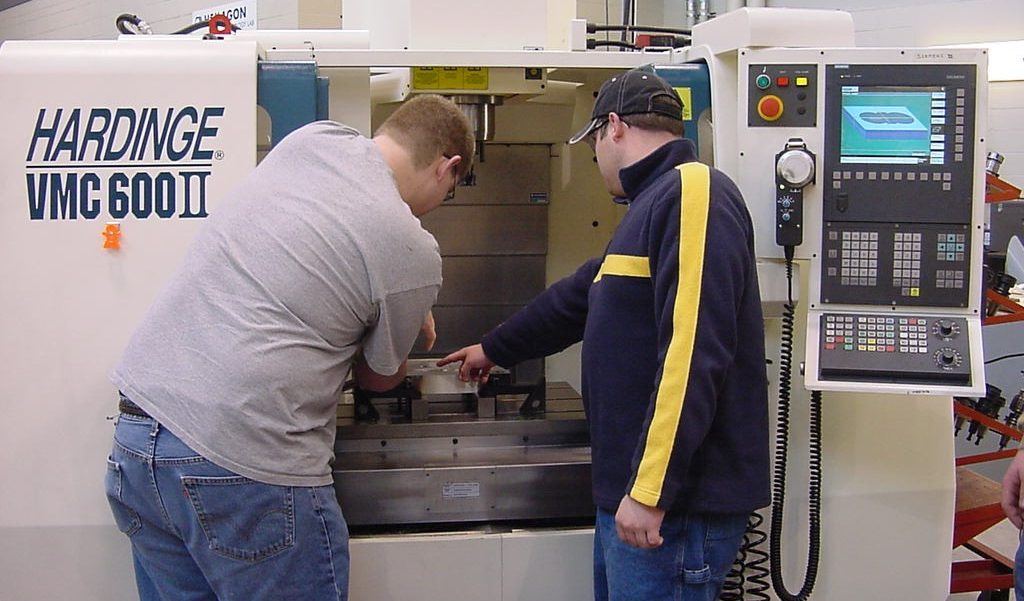Digitalization brings both new challenges and opportunities for manufacturers. It’s expected that more than three million new manufacturing jobs will be created over the next 10 years with automation, digitalization and electrification playing a much larger role within the manufacturing process. Because of an aging workforce and a skills gap, two million of these jobs will go unfilled.
Closing the skills gap is good for business, the economy and the community. Retirees take decades of skills and knowledge with them as they exit the workforce. Compounding the issue, and not as widely discussed, is that Millennials do not have the specific digital skills manufacturers require and, those who do, are choosing high tech jobs outside of manufacturing.
In today’s competitive market, a highly skilled workforce is necessary for continued success. If we do not immediately address the manufacturing skills gap challenge, U.S. manufacturers will certainly fall behind to global competition.
Barriers to Success
United States and global manufacturers know that a strong manufacturing industry is fundamental to their economic prosperity. Industry must find and keep qualified employees to expand and improve operations. While no single silver bullet exists that will solve the skills gap conundrum, there are issues we can tackle today.
At a recent Automotive Manufacturing Forum in Troy, Mich., three main barriers to success emerged from the discussion topic: employee pay, historic industry instability and workplace environment.
An automotive paint shop builder summed it up. “We’re not paying them enough to get them excited. Kids could go to college for three to four years and spend upward of $80,000. And then we’re going to offer them a job in the industry that’s well under $40,000 a year to start? They’re not interested.”
An automation technology expert added that the skills gap and pay issue began during the Great Recession when the automotive industry experienced an unprecedented downturn.
“There are a lot of kids who are old enough to remember their dads being laid off or deciding to get out of the industry. They were not encouraged to get in.”
Another participant also referred to workers who left the area during the Great Recession, to work in other parts of the country, including the Silicon Valley. Millennials view the Silicon Valley workforce model as the wave of the future. It’s all about the amenities and not just the pay. They are looking to make an impact and asking for unique perks and flexibility in their work week. Competitive salary alone is not enough to hire top talent. A change of thinking is in order to compete with software companies.
“There is no pay ceiling in the automotive business,” said a supplier to the automotive industry. “I interview five to six people a week. We have to start thinking like the software companies. That’s who we’re competing against. We’re not competing against other automotive suppliers. The investment in the workplace is really lacking.”
 Education is Essential
Education is Essential
To ensure our manufacturing future, we need to prepare the workforce of tomorrow. Members of academia, business and business organizations like SME are collaborating to create programs and find other solutions to address the skills gap.
For example, Oakland University, with campuses in Auburn Hills and Rochester Hills, Mich., is working hand-in-hand with Michigan manufacturers to create paid internships. In this program, students work with automotive and other manufacturers five to 10 hours a week during the school year and full-time in the summer. Almost all of these students are hired by local companies, including the big three automotive manufacturers.
A professor at Oakland University also referred to a program backed by Michigan Governor Rick Snyder called the Michigan Advanced Technician Training Program or better known as MAT². The program directly addresses a widening skills gap and an aging workforce. This initiative functions similar to an apprenticeship program, where students alternate between classroom instruction and on-the-job training, gaining the necessary hands-on skills and real-world experiences for them to become a successful and productive member of the workforce.
“Students are paid to go to school,” the professor said. “We cover the tuition and give them a stipend. They get paid $9 to $15 an hour. Students exit this apprenticing program without any debt and walk right into a job because companies offer them a two-year guaranteed job as soon as they finish their three-year apprenticeship.”
These internships help the companies fill open positions at greatly reduced costs.
“Manufacturers need to look at this as an investment,” he added. “They need to start apprenticing those students early on to get higher values out of those students.”
Some in the forum added companies should also consider expanding their outreach and internships to high school students.
Joseph Di Fazio of Windsor-based Brave Control Solutions, said, “All our new hires come out of co-op programs through the University of Windsor and other universities in Ontario. “These kids get a four-month experience in our company. They get paid. We throw them right into jobs. They become valuable after only a month. If we can get these kids in the first year, we get them coming back the second year, third year and fourth year. By that point we know we want to hire them. We show them the pay-scale. We show them everything. They want to come back.”
Di Fazio added that the co-op program has recently been introduced into high schools.
“We actually take high school co-ops for the summer and bring them in and get them involved in projects. We show them what the industry is about and let them go to a plant and customer sites. If they don’t want to do it, that’s fine, but if they never touch it, they’ll never know.”
One organization that has been at the forefront of manufacturing industry education and technology for decades is SME. Jeannine Kunz, director of training and development for Tooling U-SME, says the SME Education Foundation’s PRIME (Partnership Response in Manufacturing Education) initiative forms a collaborative network between high school students, educators and industry supporting manufacturing education.
“We look at the whole manufacturing ecosystem, not just the engineering level but the shop floor as well,” Kunz says. “The PRIME initiative, for example, engages regional manufacturers, local schools and other community representatives to establish tailored advanced manufacturing/STEM education providing high school students with relevant, hands-on knowledge and skills. By integrating the collective strengths of SME ranging from Tooling U-SME curriculum to engagement of SME chapters, we’re able to introduce new technologies, provide industry-driven curriculum and train teachers in schools across the country.”
Additionally, SME sponsors other educational programs and industry events throughout North America.
Developing the Workforce
Attracting new talent is certainly a high priority for manufacturers. However, companies know that their best assets are their existing highly skilled and experienced people. Because of this, they are increasing their investment in lifelong learning development and looking for new ways to ensure knowledge transfer. Recent college graduate Ben Kisley is taking part in Siemens Engineering Leadership Development Program.
“Every six months I move to a different location around the nation,” Kisley said. “I get experience from different parts of the organization and to learn from different people. I think that is a good idea for enticing new grads.”
 Siemens also offers a Workforce Performance Improvement program (WPI), which is a well-defined six-stage cyclic program providing transparency into employee job skills for success. The program begins by aligning current worker competency to business targets and approaches the learning process from the customers’ perspective. It incorporates a variety of online and face-to-face learning methods individually tailored to improve job performance and meet specific performance needs.
Siemens also offers a Workforce Performance Improvement program (WPI), which is a well-defined six-stage cyclic program providing transparency into employee job skills for success. The program begins by aligning current worker competency to business targets and approaches the learning process from the customers’ perspective. It incorporates a variety of online and face-to-face learning methods individually tailored to improve job performance and meet specific performance needs.
A large automobile transmission manufacturing plant provided a recent example highlighting the success of a WPI initiative. Engineers watched a “how-to” instructional video on-site at the time of a potential factory outage. They made the adjustment that kept the line running and prevented any downtime.
“A manager told us that the video subscription more than paid for itself at that moment,” according to Rick McNamara of Siemens.
Capturing information through technology and passing it to new workers can help reduce training time, improve collaboration and communication and help companies get to market faster.
Looking Ahead
Glenn Stevens, vice president of MICHauto and strategic development for the Detroit Regional Chamber, said a forward-thinking attitude that embraces emerging technologies is key to success.
“We still make 23 percent of the cars and trucks built in the United States. There are 1,400 tool-and-die shops in Michigan. There are more than 375 R&D centers. But we’ve got to look to the future,” Stevens said. “From the 13 assembly plants all the way down to the mom-and-pop, tool-and-die shops, we’re working to protect Michigan’s automotive assets. But if we don’t position ourselves as a center for building next-generation mobility and embrace the Internet of Everything, Michigan will be left in the dust.”
John Billings, Siemens Industry U.S. automotive segment vice president, agrees that sharing innovation with other companies is important to fill the skills gap. He says Siemens sponsors an annual event called Manufacturing in America that is built around three pillars — community, collaboration and innovation.
“It takes a community that is collaborating to drive innovation,” Billings says. “Innovation is critical if we want to continue to manufacture in the U.S. Private sector funding of manufacturing R&D accounts for almost 70 percent of the total R&D spent. If we lose manufacturing, we will lose innovation. “This is how we continue to drive for strong American manufacturing.”
Alisa Coffey | Siemens Industry, Inc.
Marcom Manager of Aerospace, Automotive and OEMS
5300 Triangle Pkwy
Norcross, GA 30092
P: (678) 427-8319
alisa.coffey@siemens.com
Eric Kaczor | Siemens Industry, Inc.
Automotive Marketing Manager
5555 New Kings Street
Troy, Mi 48098
P: (248)712-8708
eric.kaczor@siemens.com


















